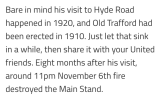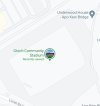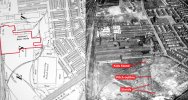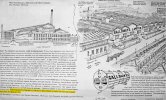You are using an out of date browser. It may not display this or other websites correctly.
You should upgrade or use an alternative browser.
You should upgrade or use an alternative browser.
Hyde Road Stadium
- Thread starter Lovebitesandeveryfing
- Start date
pride in battle
Well-Known Member
So basically behind that wall ?The ground was off Bennett Street in West Gorton/Ardwick - which is still there... where the ground was is now a Shipping container/Cargo company called 'Olympic Freigh'...
View attachment 73223
Yep - looks like the building on the left wasn't there at all and houses stood on that point.So basically behind that wall ?
It appears there was a fire...Just found this interesting drawing of Galloways by an ex employee that shows the Ground... also highlighted a bit where he mentions the main stand collapsing!?!
Not sure if Gary James can shed any light on that?
View attachment 73230

(Almost) completely irrelevant but i remember a story in one of my old football annuals about an England v. Sweden match in Gothenburg in the 1950s, in days when English folk knew little about what happened in far away foreign places. Before the match began the sun was shining more brightly in one goalmouth than the other. The England staff asked their hosts about it and were told to kick into the sun as "it would be much worse in the second half." When they came out after half time they found the sun had disappeared behind the stand and the expected advantage was lost; as, I think, was the match. Ah, those canny Swedes.An east-west orientation is unusual. Most football grounds in the UK are built north to south. I believe that this originally evolved at least in part because players are less hindered by having to squint into the sunlight in afternoon or early evening games that they would be with an east-west orientation ...
The first under bridge was a house my M8 lived in 1958 .So how long that house was built I've no idea..Go along Hyde Road to the junction with Bennett Street near where the railway crosses Hyde Road.
At that junction, the little bit of spare land is where the Hyde Road Hotel / City Gates pub was.
Turn onto Bennett Street and as soon as you go under the railway bridge the ground was on the left.
See the map I posted above your post
Mad Eyed Screamer
Moderator
Sadly the fire destroyed a lot of artifacts and information from the St Mark's days through to the Ardwick days
Lovebitesandeveryfing
Well-Known Member
Some good contributions on here. This was what I was hoping for.
Would love to know what Manchester's Ardwick Ales were like! And where they were brewed (presumably very locally). Must have been better than Tetley's, anyway (always hated the stuff, personally).
The comments about north-south orientation confirm what I've always known intuitively, without really thinking about it. Most grounds are that way. In London Stamford Bridge and Craven Cottage are more or less north-south, and the Arsenal and Tottenham stadia are exactly North-South. Brentford's new stadium, though, doesn't conform to the rule. Of course, with kick-offs now all over the place, ranging from 12.30 (coming up very shortly, as we know…) to 18.30, the old rule about where the sun is going to be doesn't really apply any more.
Remember seeing a match from first level East Stand, can't remember which, and being really bothered by the sun for most of it. Must have been a late k.o., but towards the end of the season.
It's quite something to see how Hyde Rd was hemmed in by railways and sidings. Makes you realise just what the railway revolution meant to the early and mid-Victorian period. No good producing stuff if you can't get it shifted to your markets, and that means overseas as well.
Would love to know what Manchester's Ardwick Ales were like! And where they were brewed (presumably very locally). Must have been better than Tetley's, anyway (always hated the stuff, personally).
The comments about north-south orientation confirm what I've always known intuitively, without really thinking about it. Most grounds are that way. In London Stamford Bridge and Craven Cottage are more or less north-south, and the Arsenal and Tottenham stadia are exactly North-South. Brentford's new stadium, though, doesn't conform to the rule. Of course, with kick-offs now all over the place, ranging from 12.30 (coming up very shortly, as we know…) to 18.30, the old rule about where the sun is going to be doesn't really apply any more.
Remember seeing a match from first level East Stand, can't remember which, and being really bothered by the sun for most of it. Must have been a late k.o., but towards the end of the season.
It's quite something to see how Hyde Rd was hemmed in by railways and sidings. Makes you realise just what the railway revolution meant to the early and mid-Victorian period. No good producing stuff if you can't get it shifted to your markets, and that means overseas as well.
Oyster28catcher
Well-Known Member
- Joined
- 3 Jul 2010
- Messages
- 7,633
- Location
- https://acton28.blog/
- Team supported
- CITY/Aberystwyth Town
Any plaque for City at the old Hyde Road Hotel?
Mad Eyed Screamer
Moderator
It's just a.piece.of grass at the corner of Hyde Road and Bennett Street so nowhere to put a plaque up!Any plaque for City at the old Hyde Road Hotel?
Mad Eyed Screamer
Moderator
Brentford have the same issue that City had at Ardwick.Some good contributions on here. This was what I was hoping for.
Would love to know what Manchester's Ardwick Ales were like! And where they were brewed (presumably very locally). Must have been better than Tetley's, anyway (always hated the stuff, personally).
The comments about north-south orientation confirm what I've always known intuitively, without really thinking about it. Most grounds are that way. In London Stamford Bridge and Craven Cottage are more or less north-south, and the Arsenal and Tottenham stadia are exactly North-South. Brentford's new stadium, though, doesn't conform to the rule. Of course, with kick-offs now all over the place, ranging from 12.30 (coming up very shortly, as we know…) to 18.30, the old rule about where the sun is going to be doesn't really apply any more.
Remember seeing a match from first level East Stand, can't remember which, and being really bothered by the sun for most of it. Must have been a late k.o., but towards the end of the season.
It's quite something to see how Hyde Rd was hemmed in by railways and sidings. Makes you realise just what the railway revolution meant to the early and mid-Victorian period. No good producing stuff if you can't get it shifted to your markets, and that means overseas as well.
Closed in by 2 railway lines.
The map below isn't that.clear but you can see the one line on the right side of the ground and another one running above the top of the ground

blue b4 the moon
Well-Known Member
I always thought it was where the bowling alley is/was facing the greyhound stadium.
Next time I'm around the area I'll go and have a look at where it actually was.
Sky Blue Thinking
Well-Known Member
There was a speedway stadium near the dog track til mid/late 80s. Contained a lot of wood so was probably never going to survive after Valley Parade fire.I always thought it was where the bowling alley is/was facing the greyhound stadium.
Next time I'm around the area I'll go and have a look at where it actually was.
Just over the other side of Hyde Road from Buzz Bingo is Gorton Park – we played there in our early days no sure if as West Gorton or Ardwick... best I can work out it's the area highlighted in red behind the primary school...I always thought it was where the bowling alley is/was facing the greyhound stadium.
Next time I'm around the area I'll go and have a look at where it actually was.
But, as per Gary James' talk a few weeks back, we also played at...
• Farmer's Field/Thomas Street
• Kirkmanshulme Lane Cricket Club
• Queens Road (Now Gorton Park in attached picture)
• Pink Bank Lane
• Bull's Head Hotel, Reddish Lane

Mad Eyed Screamer
Moderator
Thanks. It would have been as West Gorton or Gorton as the name change to Ardwick came about when the move to Hyde Road happenedJust over the other side of Hyde Road from Buzz Bingo is Gorton Park – we played there in our early days no sure if as West Gorton or Ardwick... best I can work out it's the area highlighted in red behind the primary school...
But, as per Gary James' talk a few weeks back, we also played at...
• Farmer's Field/Thomas Street
• Kirkmanshulme Lane Cricket Club
• Queens Road (Now Gorton Park in attached picture)
• Pink Bank Lane
• Bull's Head Hotel, Reddish HappenView attachment 73311
Nebuchadnezzar
Well-Known Member
The ground was off Bennett Street in West Gorton/Ardwick - which is still there... where the ground was is now a Shipping container/Cargo company called 'Olympic Freigh'...
View attachment 73223
The hundreds of times I've passed this and not known. I thought it was at the bus depot.
Mad Eyed Screamer
Moderator
It was the bus skid patch / training centre just a little further along (off) Hyde Road than the bus depot on Hyde Road / Devonshire StreetThe hundreds of times I've passed this and not known. I thought it was at the bus depot.
Nebuchadnezzar
Well-Known Member
It was the bus skid patch / training centre just a little further along (off) Hyde Road than the bus depot on Hyde Road / Devonshire Street
Well there you go. I'll relay that one to my old fella on the way there on Saturday. Cheers @dario2739
I always thought it was where the bowling alley is/was facing the greyhound stadium.
Next time I'm around the area I'll go and have a look at where it actually was.
There was a football ground there, could see some large double iron gates with MCFC on them. "Manchester Central Football Club". Removed about 20 odd years ago.


